 |
 |
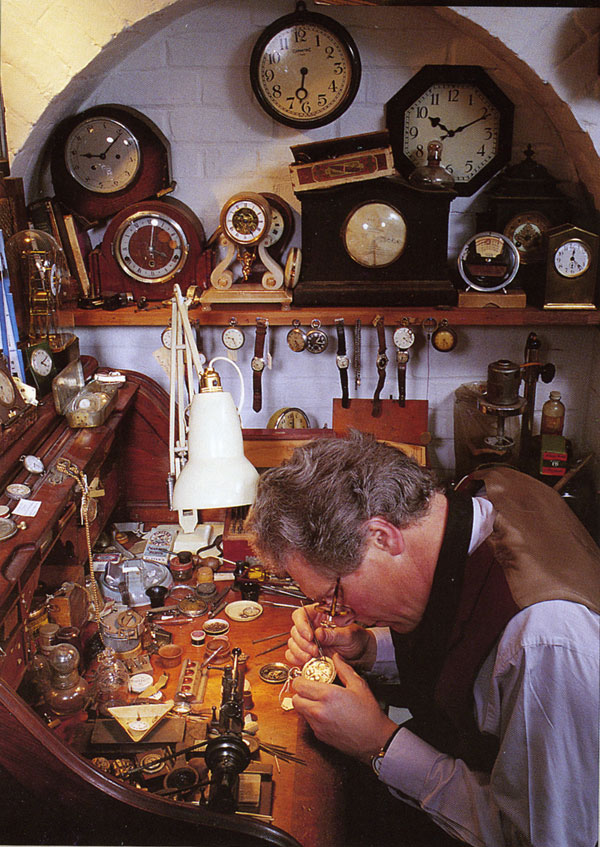
LOCAL MAKERS BEFORE 1700
John Chamberlain |
The earliest known makers from the county of Suffolk are actually from our local area here in West Suffolk. Although clocks appear to us to be simpler to make than watches, we find watchmakers to exist before clockmakers in Suffolk.
Early watchmakers did not usually make clocks as well, although this became commoner as years passed. A watch is known by W. Houlgatt of Ipswich believed to date from the 1630-40 period.
Two watches are known by Henry Terold or Thorold of Bury and Ipswich. One is known, made about 1640, and is in the British Museum. Terold is known to have been working at Bury from 1622. No clocks are known by either of these watchmakers.
So, perhaps ironically, the earliest known maker of timepieces in the St Edmundsbury area is actually a Watchmaker, Henry Terold.
Now on to clocks.
Richard Copping has been well known for many years. But there is now another possible maker identified, called Luke Cocksedge, and one clock of his, bearing a date of 1644, recently appeared on Brian Loomes's website.
Francis Coleman or Colman of Ipswich was reputedly working by 1665, believed married 1668, and was still working in 1674. One or two lantern clocks are recorded by him. Roger Moore of Ipswich was married in 1687 and died in 1727. Several clocks are known by him including two or three pendulum lantern clocks, which must date after 1660 and were probably from the 1680s. John Cole of Woodbridge was listed as a clockmaker who died in 1663, by Haggar and Miller. However, they corrected this in the Supplement of 1979, noting that this was, in fact, a misreading for blockmaker.
The clock dealer Brian Loomes has come across seventeenth-century lantern clocks by two other Suffolk makers not documented by this book.
All of the Watch and Clockmakers on this page are listed alphabetically on the left, but are described below roughly in date order. Thus the earliest makers will thus appear first.
|
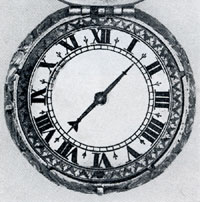 |
Henry Terold of Bury and Ipswich, fl 1620-1642 Henry Terold was a watchmaker who is known to have been working at Bury from 1622. The Bury St Edmunds Chamberlain's Accounts contain an entry for the payment of £1.0.0 from Mr Tirrell, watchmaker, on 14th March 1621. In modern terms this date would be 14th March, 1622. This payment was for his freedom of the borough, without which he could not exercise his trade within the town's boundaries. There is a cruciform pendant watch, made of silver, and dated to about 1640, signed "Henry Terold of Bury", in the British Museum, in London. It has engraved scenes of the Crucifixion, Nativity and Adoration.
|
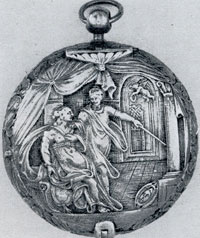 |
Baillie recorded a fine engraved silver cross watch, from c1640 in the Mallett collection. Britten recorded a round silver watch-case with interlacing bands and silver dial in the Fellows collection. He dated it also to c1640. This watch was signed with Ipswich as its place of origin. Haggar and Miller found a mid 17th century verge watch in the Victoria and Albert Museum, signed, "Henry Terold Ipswich Fecit". The case is described as a fine example, made of cast silver, with chiselled scenes of an allegorical nature. The dial is silver, with a blued steel hand. It is dated to about 1650. Both the watch and the outside of the case are illustrated here. The work is clearly of the highest order. Henry Terold or Therold therefore seems to have been working in Ipswich at some point. Haggar and Miller could find no other trace of Henry Terold in any records.
|
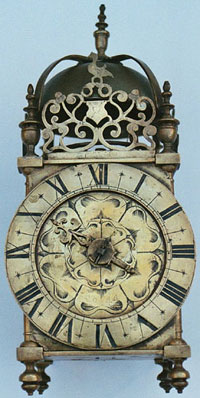 |
Luke Cocksedge of Bradfield St George, 1585-1652+ Luke Cocksedge is not a clockmaker who was recorded in the main work on 'Suffolk Clocks and Clockmakers' by A L Haggar and L F Miller. However, a newly discovered Lantern Clock was identified by a Dealer in Antique clocks, and is described below. This information on Luke Cocksedge is taken from the website of the well known clock dealer, Brian Loomes of Harrogate, at www.brianloomes.com. Brian Loomes writes as follows: "No Suffolk clockmakers are known to be working anywhere near as early as the evident period of this clock by Luke Cocksedge, which pre-dates the oldest previously-known Suffolk clocks by a generation. The clock is signed at the base of the front fret with a name hitherto completely unrecorded in the world of clockmaking: 'Luke Cocksedge fecit'. This position for a signature on the front fret is typical of the period when the clock was made, being what we now usually call a First Period clock. In the centre is a heart pierced through by, not one, but two arrows. Above the heart is an engraving of an eye from which tears drop down. The year 1644 is scratched, rather than professionally engraved, onto the dial front. We have no way of knowing if this was done at the time the clock was made, but that seems unlikely. The Civil War was in progress at this time, and it has been suggested that the two arrows piercing a heart symbolise the two warring factions which split family loyalties and affections into two as well as the whole nation. A general search of surnames over a widespread area at this time located the name Cocksedge only in one district in Suffolk, at the extreme opposite side of the country from where the clock seemed to originate. Frustratingly no lantern clock of Suffolk origin by any maker is known with any of the distinctive features of this particular clock, but then no Suffolk lantern clock of this age has been recorded till now. Searching again in the light of this new knowledge, I found a superfluity of Luke Cocksedges - three in fact! These were also in Suffolk, and it transpired that my locating the very rare version of Cockedge there, arose through mis-spellings of the more usual form of Cocksedge, or Coxedge. From having none we now had too many. The first was born about 1555 at Norton just east of Bury St. Edmunds in Suffolk. Another, who proved be the son of the first, was baptised in 1585 at Norton. A third, who was the son of the second, was baptised at nearby Bradfield St. George in 1620. Luke Cocksedge (I) died in 1621, leaving a will, which mentioned his son, Luke (II). The age of the clock indicated it must have been made by Luke Cocksedge (II) of Bradfield St George, who was born in 1585 and who proved to be still alive in 1652. Luke Cocksedge was born in 1585, married in 1616, had five children born between 1617 and 1628. Tragically his youngest son., Thomas Cocksedge, died in 1652 aged only twenty four. It seems more than likely that Thomas was a soldier in the Civil War for he died away from home at Newcastle on Tyne, a place which featured prominently in the war. His will, leaving everything to his father, was of the type called a 'nuncupative' will. Such wills were accepted as being made, even though not written down, principally by serving soldiers, whose wishes were accepted as having been spoken to a comrade with a dying breath, and were reported to the authorities later by that comrade by word of mouth. Luke Cocksedge was sixty seven years old when his son was buried. It is not known when he died." Another source, the website of Linley Hooper at http://www.linleyfh.com/p2566.htm, states in more detail, as follows: 'Luke Cocksedge was christened on 12 April 1585 in Norton, Suffolk. He was the son of Luke Cocksedge and Rachel Gooch. Luke Cocksedge married Frances Spark in 1616 in Hawstead, Suffolk. Frances Sparke was the daughter of a widow also named Frances Sparke. Frances, the mother, re-married in 1617 to yet another Sparke, one Henry Sparke, no doubt a close relation of her first husband of that same surname. Henry Sparke had a son, Robert, who proved not to be Robert Sparke the clockmaker. Henry also had a godson of that same name, Robert Sparke - we don't know who he was. Robert Sparke the clockmaker must surely have been related by marriage to Luke Cocksedge, but I have been unable to establish the exact relationship. He was mentioned in the will of John Baker the elder of Gt Ashfield 14 Jan 1627/8: I give to Ellizabeth my wife my house in Bradfeild St George in which Luke Cocksedge dwell .... Luke Cocksedge and Luke Cocksedge were named in the militia list taken in 1638 in Drinkstone. The 1638 militia list has only one Luke Coxhedge, at Drinkstone. This may be father or son Luke who would have been 18 and more likely for the militia but they had to be between 16 & 60. Luke Cocksedge paid 2/7/3 ship money in March 1639/40 in Drinkstone. He was a churchwarden in Drinkstone, Suffolk, in 1640. He appears to have been the clockmaker Luke Cocksedge. The age of the clock indicated it must have been made by Luke Cocksedge (II) of Bradfield St George, who was born in 1585 and who proved to be still alive in 1652.'
Richard Copping of Bury St Edmunds, fl 1640-1689 Richard Copping may have worked in Bury St Edmunds from about 1640, but the earliest date we know he worked there was from 1654, marrying there in 1662, and dying there in 1689. Only a couple of clocks are so far documented by Richard Copping, one longcase and a solitary lantern clock, though there may well be others surviving. His name was spelt Coppin, Coppinge and Copping, which is the modern spelling. Britten recorded the long case clock signed as "Richard Coppinge, at St Edmunds Bury in Suffolke". The lantern clock was signed "Richard Copping, St Edmunds Bury." Richard Copping's death in 1689 seems to have left Bury without a clockmaker until about 1701, when we know he was followed there by Mark Hawkins the First. When Richard Copping died, Mark Hawkins was still a child and Richard Rayment was still only a baby. Robert Sparke of Cockfield, ?-1648 Robert Sparke was a clockmaker at Cockfield, who wrote his will in 1647, and died in 1648, leaving the tools of his trade to his son, William Sparke. No example of work has so far been recorded by either Robert Sparke or his son, William, but this is a record of a clockmaker from the time of Luke Cocksedge, who lived only three miles away from him. In his will he was stated to be a clockmaker, one of the earliest uses of that term in Suffolk. It is most likely that he must have known the only other man in the county who practised the craft three miles distant - Luke Cocksedge. Either they were working in association or were rivals. One dealer has suggested that rivals for that sparse early clock trade would have positioned themselves as far apart as possible, making an association more likely. Robert Sparke had around half a dozen surviving children, one also called Robert, though Robert junior seems not to have been a clockmaker. In fact Robert Senior left his working tools to his eldest son, William Sparke. The family history website of Linley Hooper at http://www.linleyfh.com/p2566.htm has further details, as follows,: ' Robert Sparke (the only other known clockmaker of the period in Suffolk) was born before 1575 and was at least ten years older than Luke Cocksedge. Luke would have been apprenticed about 1599 at the age of about fourteen, when Sparke was twenty-four or older, and Sparke was the only person in the region, perhaps in the county, who could have taught him. Luke would have finished his seven year term about 1606, may have worked for Sparke for a year or two as was customary, or perhaps longer, before working for himself. By 1616 at the age of thirty-one Luke was sufficiently prosperous to marry. It may be that the Sparkes, father and son, and Luke Cocksedge worked mainly on church clocks, for there seems to be no recorded output by any of them, other than this present clock. Yet between them the two Sparkes worked at clockmaking it would seem for over sixty years. Add on the working life of Luke Cocksedge of about forty-five years or so, and we have a combined working life of over one hundred man years with only a single clock to show for it. When Robert Sparke died aged at least seventy three leaving the tools of his trade to his son, William, Luke Cocksedge was sixty three, William Sparkes was forty-eight. Unless they worked almost exclusively on church clocks, where, we might ask, are all the domestic clocks these men made in their lifetimes- which could only have been lantern clocks for there were no other kinds? We know the destruction rate of lantern clocks was high, but was it so high that no other example has yet been recorded from a combined working life of a hundred years?. He was an executor of Thomas Cocksedge's estate on 13 February 1652/53 in the Prerogative Court of Canterbury.'
|
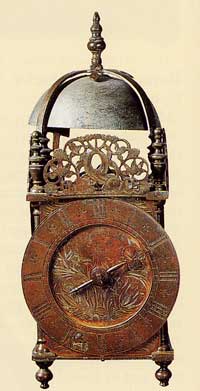 |
Benjamin Stribling of Stowmarket, 1663-1720
Benjamin Stribling of Stowmarket was born around 1663 and died in 1720. The first mention of Stribling occurs in Stowmarket’s Parish Records - a marriage licence dated 16 July 1693. This clock was made around 1700, has a recoil escapement and, judging from the crude way it is constructed, it could be one of the first attempts by this maker to construct one. Like all lantern clocks of this period, it is weight driven, with count wheel strike and hangs on the wall like a lantern. This clock is part of the Gershom Parkington Memorial Collection of clocks and watches. The collection was on display in the Manor House Museum in Bury St Edmunds until 1st April, 2006, when the museum was closed to save money. When first made the brass on this clock would have been cleaner and brighter but would quickly have dulled down to its present chocolate colour. Dials were not silvered except perhaps those made in London. The centre of the dial is engraved as is the front fret above the dial. The two side frets are not engraved. The lantern clock is one of the oldest forms of domestic clock. It developed into this classic form - brass cased, single hand, fret work and bell surmounting the movement - in James I reign (1603-1625). It has remained virtually unchanged in succeeding centuries and is still being made today. Haggar and Miller, in the 1979 Supplement to the Clockmakers of Suffolk, also identified a Joseph Stribling of Stowmarket, who also made clocks. He left a very fine Long Case clock, signed, "Joseph Stribling in Stowmarket in Suffolk." A man of this name was buried at Stowmarket on 23rd November, 1694.
|
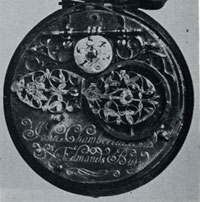 |
John Chamberlain or Chamberlaine, Bury St Edmunds, b1644-d1727 This John Chamberlain was the son of a watchmaker also called John Chamberlain, who was associated with Ipswich. John the elder died in 1675, and a silver watch is known by him signed "John Chamberlaine Ipswich fecit", sold at Sotheby's in 1971. John junior was baptised at St Mary le Tower, in Ipswich, on 20th July, 1644. At some point he moved to Bury. John Chamberlain was a Freeman of the Clockmaker's Company in 1687, and was Alderman (we would call him Mayor), of Bury in 1700-1701. Haggar and Miller reported a silver verge watch in the British Museum signed, "John Chamberlain St Edmonds Bury". It is dated to c1670, and has a silver case and silver champleve dial with a calendar ring. This watch is shown here, and a view of the dial can be seen by clicking on the illustration. In 1933 F J Britten recorded that lantern clocks were known by Chamberlain, but Haggar and Miller could not trace these in 1974.
Isaac Hurst, Bury St Edmunds, 1677- Isaac Hurst was unknown to Haggar and Miller in both their 1975 and 1979 publications on Suffolk Clocks and Clockmakers. However, Brian Loomes, well known clock dealer and author of many books on the subject, has come across seventeenth-century lantern clocks by other Suffolk makers not documented by this book. One was an example from the very end of the century by Isaac Hurst, who was probably the maker of this name who trained in London till 1677, and then moved to work in Bury St. Edmunds some time after 1677. (Another was dated by Loomes to about 1670 or 1680 by Stephen Levitt of Sudbury. A third was the Cocksedge clock detailed above.)
John Manley, Bury St Edmunds, 1686-d1721 John Manley was the brother of Caleb Manley and Daniel Manley. Their father was Daniel Manley (1st), a Clockmaker in Great Yarmouth between 1650 and 1701. Caleb became a Watch and Clock maker in Beccles until his death in 1739, and Daniel (2nd), set up in Great Yarmouth, until his death in 1729. John Manley was married at Redisham, and moved to Bury. In 1697 there was a watch by him advertised as lost. It was described as "with a pendulum". There is a receipt dated to August 23rd, 1710, in the West Suffolk Records Office. It reads:
"August the 23 1710. In modern terms this appears to be a sale of a watch, with a One Year Guarantee, for a price of £6. Another advertisement in the Ipswich Journal for 10th October, 1743 said. "Lost, large silver watch, the makers name 'Manley, Bury St Edmunds', it moves with a pendulum, over which is a white glass in the form of a half moon." John Manley died in 1721 and was buried at St Mary's church.
Samuel Frost, Bury St Edmunds, d1700 Samuel Frost was unheard of until 1975, when a clock bearing his name was sold at Sotheby's. Therefore he was not included in Haggar and Miller's work until the Supplement was published in 1979. The clock was a Lantern Clock with anchor escapement, dolphin frets and urn finials. The 6.5 inch dial was signed, "Sam Frost, St. Edmundsbury." It seems likely that this man was the "Samuel Frost, Locksmith", buried at St Mary's church in Bury on 2nd December, 1700. It was normal at this time for locksmiths to also handle clocks.
Now click here to move on to The local 18th Century Makers
|
|
"Time Measurement Instruments- catalogue of the John Gershom Parkington Memorial Collection" 3rd edition of 1979 Information first prepared by David Addy, 27th April 2006
|
| Go to Clocks Homepage | Last Updated 20th November 2019 | Go to Home Page |